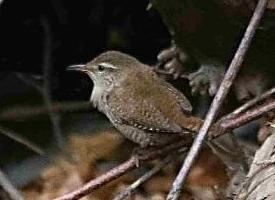
Váhy a míry
| Délka | od 9 do 10 cm |
|---|---|
| Hmotnost | od 6 do 12 g |
| Délka rozpětí křídel | od 13 do 17 cm |
Biologická data
| Délka života | od 3 do 7 let |
|---|
Popis zvířete
The Eurasian wren (Troglodytes troglodytes) is a small, yet remarkably energetic bird, known for its distinctive short tail that is often seen held upright, and its rich, melodious song that fills the air, especially during breeding season. This diminutive bird, one of the smallest in the Eurasian avifauna, possesses a round body that aids in retaining heat, an essential adaptation for surviving in its often cool and damp habitats.Sporting a predominantly brown plumage that provides excellent camouflage among the underbrush and woodland floors, the Eurasian wren features subtle barring on its wings and tail, with a slightly paler underside. This coloration not only blends seamlessly with its environment but also aids in its protection against predators. Its sharp, slender beak is perfectly adapted for foraging insects and spiders, which constitute the bulk of its diet. This adept hunter is often seen hopping energetically on the ground or among tangled vegetation in search of its next meal.
One of the most remarkable aspects of the Eurasian wren is its powerful voice. Despite its small size, this bird can produce an astonishingly loud and complex song, a series of clear, melodious trills and chatters that can be heard echoing through its habitat. Males are particularly vocal during the breeding season, using their songs both to attract mates and to defend their territory.
The Eurasian wren inhabits a wide range of environments across its extensive range, which spans from the Iberian Peninsula and North Africa across Europe and Asia to the Pacific coast of Russia and down into parts of the Middle East. It shows a preference for dense undergrowth in forests, gardens, and hedgerows, where it can find ample food and shelter. Despite its small size, it is a hardy species, capable of withstanding the harsh winters of northern climates, although populations in the colder regions may migrate to more temperate areas during the winter months.
Breeding season sees the male Eurasian wren engage in an impressive display of industriousness, building several globular nests out of moss, leaves, and feathers in hopes of attracting a female. These nests, camouflaged among the dense vegetation or in crevices of walls, are a testament to the bird's architectural prowess. Once a female selects a nest and mates with the male, she will lay a clutch of five to eight eggs, which she incubates for about two weeks. The chicks are born altricial, meaning they are initially blind and featherless, entirely dependent on their parents for warmth and nourishment.
Despite facing threats from habitat loss and degradation in parts of its range, the Eurasian wren has maintained a stable population, thanks in part to its adaptability and the broad range of habitats it can call home. This resilience, coupled with its enchanting song and spirited demeanor, makes the Eurasian wren a cherished presence in its native territories, embodying the wild spirit and intricate beauty of the natural world.
Podobná zvířata
Nové fotografie zvířat
Top 10 zvířat
- Dolphin gull (Leucophaeus scoresbii)
- Diana monkey (Cercopithecus diana)
- Stone loach (Barbatula barbatula)
- Greek tortoise (Testudo graeca)
- Moustached guenon (Cercopithecus cephus)
- Japanese macaque (Macaca fuscata)
- Galápagos tortoise (Geochelone nigra complex)
- Russian tortoise (Testudo horsfieldii)
- Galápagos penguin (Spheniscus mendiculus)
- Common flying dragon (Draco volans)

